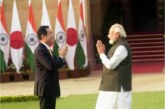Dr Arvind Kumar, *President, India Water Foundation, New Delhi
On the night of 15 April this year some 25-30 soldiers of China’s People’s Liberation Army (PLA) came 10 km inside the Indian territory in Burthe in DBO sector in Ladakh, which is at an altitude of about 17,000 feet. On 23 April, military delegations from both sides met again to try and resolve the standoff, but a four hour long meeting failed to break the deadlock, prolonging the latest flashpoint between the two nuclear armed powers.
While rejecting reports of intrusion by the Chinese troops in Ladakh, the spokesperson of the Chinese Foreign Ministry, Hua Chunying, told the media persons in Beijing on 22 April that the PLA soldiers patrolled the Chinese side of Line of Actual Control (LAC) without “trespassing” into it.
The Chinese spokesperson also added: “China’s position is firm and clear. We have been abiding by the agreement of the two countries having normal patrol on Chinese side and never trespassed the LAC.” The Chinese spokesperson said during the course of her replies: “China believes that the current India-China relations have been in a fine shape. We have maintained good communication and coordination on the boundary issue. We would like to solve the boundary issue through proper mechanisms in order to create conditions for the development of China-India relations.”1
Some Indian observers find China’s stand defending its ‘incursion’ as puzzling as it may result in raising of a new dispute on the much agreed LAC by the two countries which brought about a semblance of calm while they negotiated the boundary dispute. The perplexing question is as to why Chinese troops chose to move forward especially when the relations between the two countries improved a great deal and ahead of reported plans of Indian External Affairs Minister Salman Khurshid to visit China on 9 May and the proposed visit by China’s new Premier Li Keqiang to New Delhi on 20 May 2013.
The pattern of India’s relations is characterized by strategic complexity and future importance defies any easy explanation. According to one opinion: “Theirs is a relationship that straddles the entire breadth of geopolitical possibility, encompassing points of conflict and cooperation in the military and economic spheres, territorial and resource disputes, dissonant domestic political systems, and perhaps most importantly: the unprecedented opportunity for two of the greatest development success stories in human history to shape the world of the 21st century. Because conflict or not, both countries recognize the need to work together to lubricate the international system that has served them so well.”2
Vexing Border Issues
Unresolved border issues in Arunanchal Pradesh and the Ladakh region of Jammu-Kashmir loom large between two countries. In the aftermath of the 1962 Sino-India war, there have been scattered diplomatic flare-ups and unauthorized excursions since then. China on many occasions declared that the entire Indian state of Arunanchal Pradesh belongs to it. When in 2009 India announced the deployment of additional troops and air power along its Himalayan border with China, it prompted Beijing to re-assert its claim to approximately 90,000 square kilometers of disputed territory.
Beijing and New Delhi have put in place several mechanisms to ensure that small incidents on the border do not get out of hand despite continued incursions and intrusions by both sides. While neither side wants the current situation to escalate beyond the local level, domestic factors in both countries makes it difficult for the two governments to devise a solution that doesn’t look like one side has conceded too much to the other.
So even as China demands that India stop developing militarily useful infrastructure on the border, it continues to stress it seeks a comprehensive strategic partnership with New Delhi. China’s two-proged approach can be seen in some quarters as a strategy to keep India engaged strategically while keeping it off balance tactically.
The new Chinese President Xi Jinping has largely reiterated his predecessors’ five point formula for moving the India-China relationship forward. On the border issue, for instance, Xi has simply reiterated former Chinese Premier Wen Jiabao’s assertion that the resolution of the boundary problem is not easy and therefore the two sides must concentrate on other factors.
Water Diplomacy
The disputed area also has an important environmental dimension, one that could come to impact the strategic balance between India and China as water scarcity becomes more pronounced in the future. The Tibetan plateau feeds the Brahmaputra River, which flows through Assam before it meets the Ganges in Bangladesh and ends at the Bay of Bengal. The government of China is building a dam at the upper reaches of the Brahmaputra, and has recently approved the construction of three additional dams as part of its 12th Five-year Plan.3
Some quarters in India nurture the apprehensions despite the fact that these dams are located in Chinese territory and the Chinese authorities have assured that they won’t impact the downstream flow of the Brahmaputra.
The issue was raised by Prime Minister Manmohan Singh when he met the new Chinese president, Xi Jinping, on the sidelines of the recently held BRICS summit in Durban, South Africa. India asked China to set up a mechanism so that the two countries can jointly assess Chinese construction projects on the Brahmaputra, which originates in the Himalayas. President Xi said China would consider the proposal. India wants to be consulted before China makes such construction decisions.
South China Sea
South China Sea is of immense strategic significance for India because many of its interests are at stake in this region. About half the world’s merchant fleet sails through the South China Sea every year and Indian trade contributes to the massive amount of shipping that traverses these waters. Accordingly, India has an interest in maintaining its ships’ free right of movement in what it views as international waters.
India’s energy interests are also at stake in South China Sea, as India’s Oil and Natural Gas Corp (ONGC) has a joint oil exploration venture off the coast of Vietnam, an asset that India would like to defend. Besides, the South China Sea is also an important factor in India’s ‘Look East’ policy, which envisions deepening political, military, and economic links with the ASEAN countries.
Under the given circumstances, India can ill-afford to propel its influence into South China Sea beyond a certail limt in the wake of China’s Indian Ocean policy of the ‘string of pearls,’ a few notable of which are a port in Gwadar, Pakistan which China took over operations for in 2012, the Hambantota port complex in Sri Lanka, and China’s reported naval base in Seychelles. As one analyst has pointed out that though India is “still several years from a Chinese blue water navy that could use these bases and turn an abstract threat into a concrete one for India, it’s understandable that India would seek to project its own naval power into China’s backyard, albeit in a similarly hypothetical fashion.”4 China, clearly, is not enthusiastic about India playing a bigger role in the South China Sea.
Cooperation or Competition
Chinese officials like to describe China and India as ‘partners in win-win cooperation, not rivals in competition.’ However, for India its relationship with China has elements of “coordination, cooperation and competition.” Africa can be said to be an arena of competition where China is substantially ahead in trade and India is a big player also. In 2012 when Prime Minister Manmohan Singh spoke about a “new era in African-Indian relations”, he pointedly said that India “wanted to employ local labour”, a clear allusion to China’s much- criticised policy of bringing its own workers to Africa.
At BRICS summit meeting, Chinese President Xi asserted that the world was big enough for both countries to develop and added that China regarded ties with India as one of its most important bilateral relationships. On the other hand, Indian Prime Minister assured China that India would not be used as a tool to contain China. He added that Tibetans in India would not be allowed to conduct activities against China. According to one analyst, despite such mutual pledges of goodwill, “suspicions linger and may well be growing.”5
Conclusion
Many scholars feel that China and India can manage the elements of competition in their bilateral relations. According to Sanjaya Baru, director for geoeconomics and strategy at the London-based International Institute of Strategic Studies, the bilateral relations between China and India are characterized by elements of both cooperation and competition.
In the opinion of Huang Jing, director of the Center on Asia and Globalization, a unit of the Lee Kuan Yew School of Public Policy at the National University of Singapore, the rise of both India and China are fundamentally different from the process of rising for the traditional powers.
While asserting that the rise of the major powers had been traditionally characterized by their “having to challenge the existing international order,” China and India have not challenged the international order and they “try to integrate into the international order.”6
According to Kanti Bajpai, vice dean of the Lee Kuan Yew School of Public Policy, the idea of China and India “in inevitable conflict is open for deconstruction.” In his opinion, both countries are actually not the rivals in the traditional sense as described by some of the media, rather what is potentially worrying is rising nationalism and the role played by the media.7
China is a big challenge for India. In order to meet China’s chaalenge, India neeeds to consolidate its internal and external position in terms of defence modernization, economic growth and political stability. India has to sharpen its diplomatic skills and make its regional and international presence felt through pro-active diplomacy.
Notes
- PTI, “Chinese incursion into India: Two Chinese helicopters entered Indian space”, Daily News and Analysis, 22 April 2013, http://www.dnaindia.com/india/1825687/report-chinese-incursion-into-india-two-chinese-helicopters-entered-india-airspace.
- Zachary Fillingham, “China-India Relations: Cooperation and Conflict”, Geopolitical Monitor, 7 April 2013, http://www.geopoliticalmonitor.com/china-india-relations-cooperation-and-conflict-4798/
- For details see, APDForum, “China approves hydropower dams, neighbors voice concerns”, apdforum.com, 4 March 2013, http://apdforum.com/en_GB/article/rmiap/articles/online/features/2013/03/04/china-india-dam.
- Fillingham, n.2.
- Frank Ching, “China-India ties based on cooperation and competition”, New Strait Times, 11 April 2013, http://www.nst.com.my/opinion/columnist/india-china-ties-based-on-cooperation-and-competition-1.252826.
- Xinhua, “China, India can manage elements of competition in bilateral relations: scholars”, Global Times, 27 April 2013, http://www.globaltimes.cn/content/777898.shtml#.UX5N0UqkPFw.
Article published in Third Concept/May 2013/


